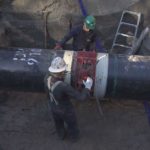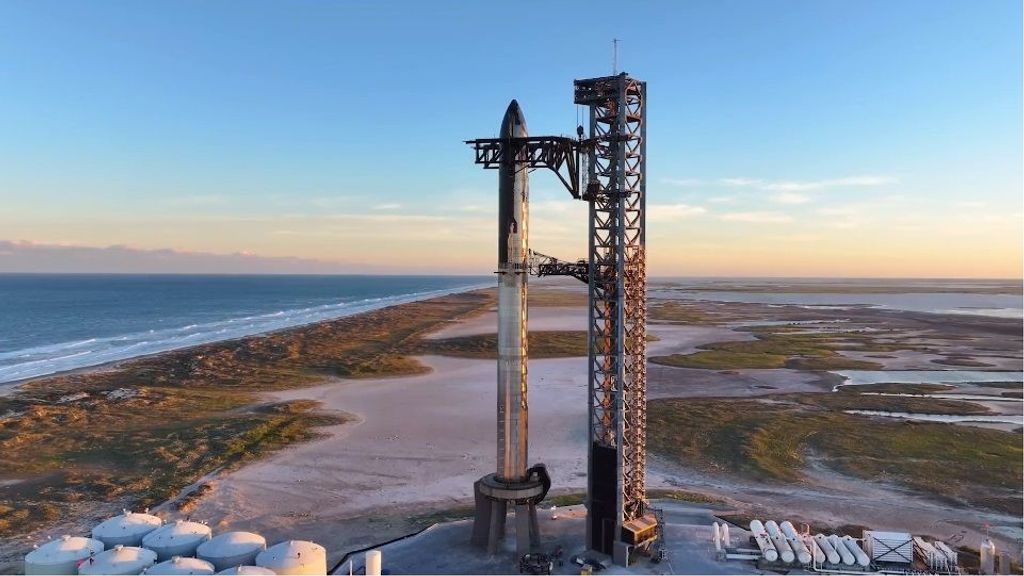Noos News•
-
Ivo Landmann
Online editor
-
Ivo Landmann
Online editor
Today, SpaceX will attempt to launch a Starship prototype into space for the second time. It is the most powerful rocket ever, which is supposed to take people to the Moon and Mars within a few years. The launch is scheduled to take place at 2:00 PM Dutch time or within 20 minutes thereafter.
The test flight is awaited with mixed emotions in the town of Port Isabel, about 10 kilometers from the SpaceX launch site in Texas.. They clearly remember the first launch attempt on April 20 of this year. The concrete beneath the launch pad was then blown away by the force of the earthquake. The wreckage, which was the size of a car, fell hundreds of meters away. A 7-meter-deep crater was formed and dust was scattered in the streets of Port Isabel. The missile itself had to be detonated after more than 3 minutes because it was not gaining enough speed.
Lots of changes since the last attempt
This time, the city’s residents no longer have to worry, predicts space expert Ronald Klombe, of the Aviodrome’s Space Department. SpaceX has made several changes to both the launch pad and the two-stage rocket.
One thing that went wrong on April 20 was the failure of Elon Musk’s aerospace company to install a sprinkler system that used a massive amount of water to dampen supersonic combustion gases and sonic shock waves. NASA has used such a system for many years.
At first, SpaceX thought it could do without it. “In the run-up to the first launch, they discovered that they would actually need such a water system,” Klompe recalls. “But it wasn’t ready in time for April 20. So they put heat-resistant concrete under it and hoped for the best. But that didn’t go well.” The water system has now been installed and tested several times.
fire
The missile itself also consists of a booster so heavy Moreover, the spacecraft itself has been improved. During the April flight, six of the missile’s 33 engines did not work. A fire broke out in the engines.
An improved fire-fighting system has now been installed and the engine targeting system is fully electric, so no flammable hydraulic oil is required. “There are hundreds of other improvements. The engines themselves also come from a later generation. So they should be more reliable.”
60 percent chance
SpaceX estimates the probability of success of the entire flight at about 60 percent. The main goal this time is to get the spacecraft to break free from the booster, fly autonomously and land in the sea near Hawaii. To be on the safe side, shipping and air traffic have been halted in the area, near Texas and Hawaii.
In this version, the company relies on an old technology that was widely used, especially by the Russians: Hot staging. the The spacecraft’s engines are already running while the spaceship is still attached to the booster. This makes for a risky maneuver so heavy Unnecessary, but there is a greater risk of harm. “This is not a problem at all with a disposable missile, but the goal is for this system to be completely reusable. So there is a special ring above the so heavy To divert very hot gases away.”
Aerospace engineer Eric Lahn expects the spacecraft to go further this time than it did in April. “I think this will work, and the higher the speed, the greater the chance that the spacecraft will make the full planned flight.”
He hopes to get amazing photos this afternoon. “This new water system will cause a huge cloud. Perhaps we will also get images from the spacecraft itself.”
delay
All the changes, especially the long lack of permission from the US aviation authorities, caused months of delays. The question is whether the spacecraft is still on schedule. NASA wants to use a version of the spacecraft as a lunar lander, and the first landing (since 1972) is currently scheduled for the end of 2025, but according to Klombie, that is not possible at all. He expects that “it won’t be long before NASA adjusts this to 2026 or later.” “New Moon suits are far from being airworthy.”
Meanwhile, SpaceX is not standing still. “They now have a new generation of rockets ready with new improvements, because they really want to send a ship into orbit with the third test launch.”








